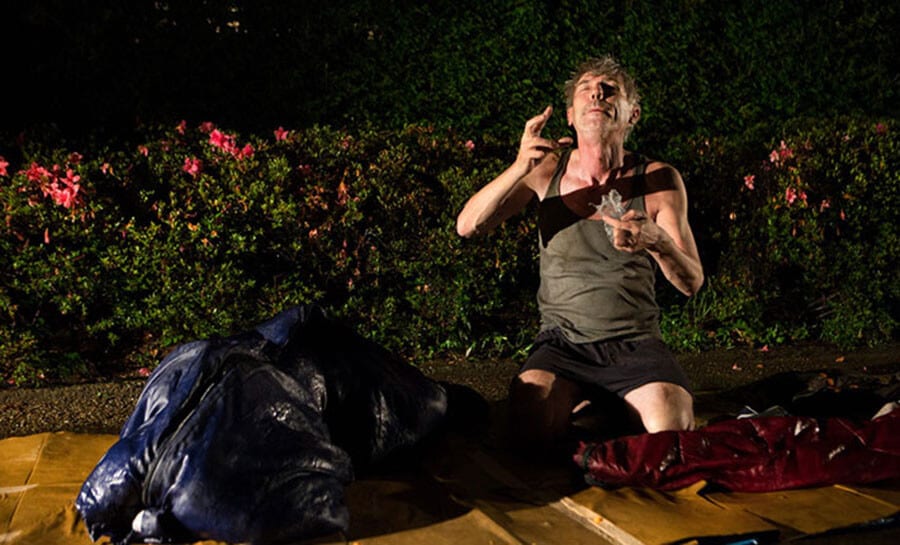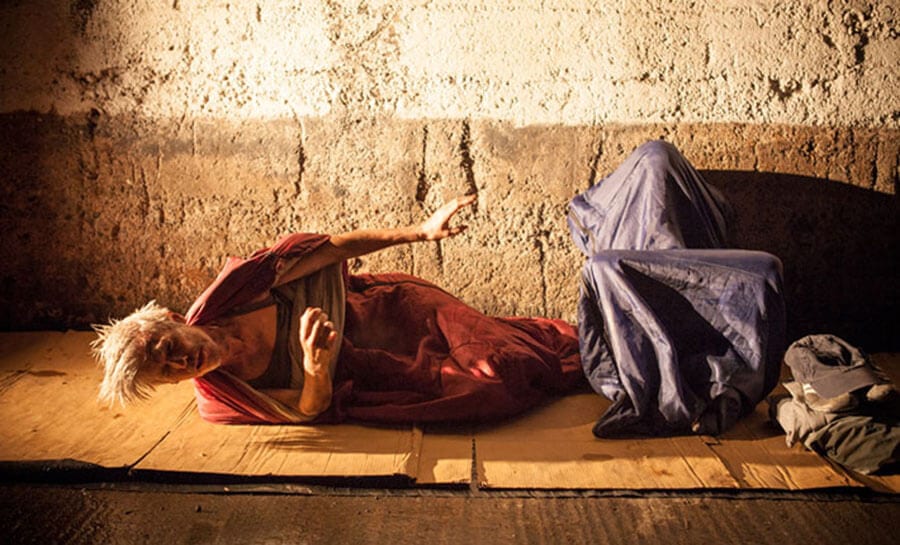After gathering in the foyer by the Advanced Box Office we are led to an outside location on the Barbican estate. I am not permitted to reveal the location, plus I would not want to spoil the surprise anyway. The humid weather had threatened the possibility of a storm throughout the day but the weather held. Perhaps it would have been a fitting sense of pathetic fallacy a violent storm had provided the atmosphere for Company SJ’s production of Beckett’s two short plays, Rough for Theatre I and Act Without Words II. Present in both acts are homeless characters who live, beg and wander the streets. Director Sarah Jane Scaife has worked on Beckett’s challenging drama in numerous environments ranging from Dublin to a bus station in Kuala Lumpar. It is a play which has setting and environment at its helm. Scaife describes how the characters are ‘placed to interact with different social and architectural spaces in the city, performing themselves and the city in a unique way each night’. Indeed, the wave of sirens from the distance seeped into the dialogue between the two characters in the first play, Rough for Theatre I brilliantly, adding an air of authenticity to urban landscape in the drama.
In Rough for Theatre I we meet an old blind man (Trevor Knight) painfully scratching away at a fiddle whilst he busks. A second character rolls into the scene on a wheelchair (Raymond Keane) and the two make acquaintances of one another. The two exchange in typical Beckettetian dialogue with an unerring rapid exchange of conversation which captures tragic-comedy at its finest. Raymond Keane’s fiery performance as the one-legged wheelchair-bound character is exemplary and the two complement one another well. As with the majority of Beckett’s drama, the two quarrelling central characters demonstrate a desperate dependence on one another in the complex struggle of everyday life. After a slightly awkward five minute interval we are ushered a short distance to the location of the second play, Act Without Words II. As the title implies, the play is bereft of dialogue and we witness two homeless men waking and leaving their sleeping bags. A sense of isolation is created by the fact that the two men perform their routines at different times, never encountering one another outside of their cocoons. Whilst it may be in act without words, the play is by no means devoid of sound. Again, cars and police sirens provide urban leitmotifs which develop a soundtrack to the world-less scene. Raymond Keane reappears in this play alongside Bryan Burrows and he excels once more. Designer Aedín Cosgrove’s use of invasive lighting works well, harshly infiltrating the scene.
The play works well on the whole, and its endeavours to explore and depict urbanity are interesting. However, it falls short slightly in terms of location. Perhaps if the play was moved to some grotty street corner rather than a designated area in the Barbican estate, it would truly grasp a sense of urban authenticity. Nevertheless, the use of space and sound is effective and an admirable effort. Overall this is an enjoyable production which caters for the challenging and provocative nature of Beckett’s two short plays; performed and directed with passion.



